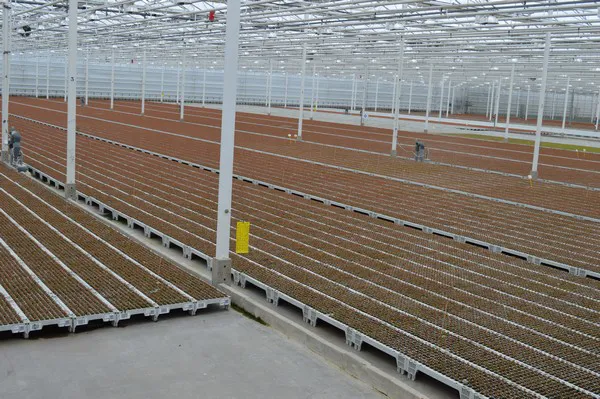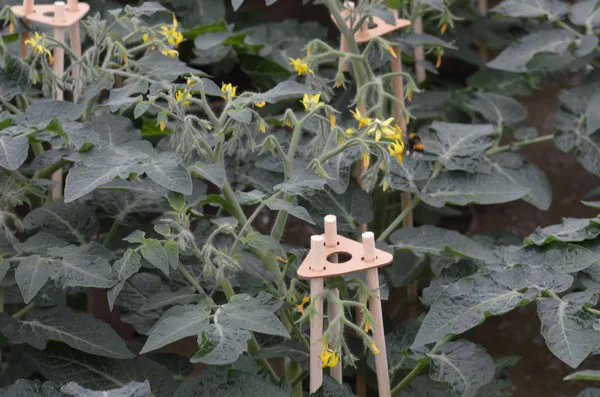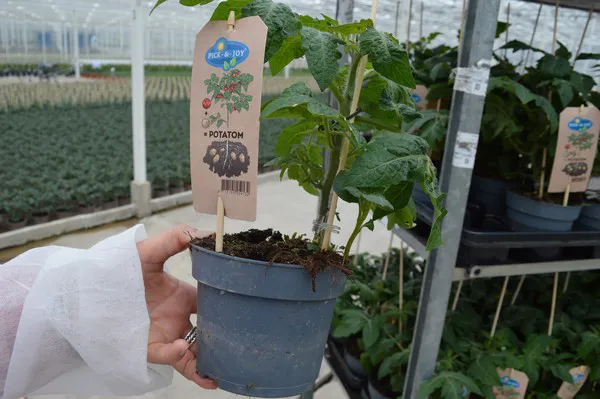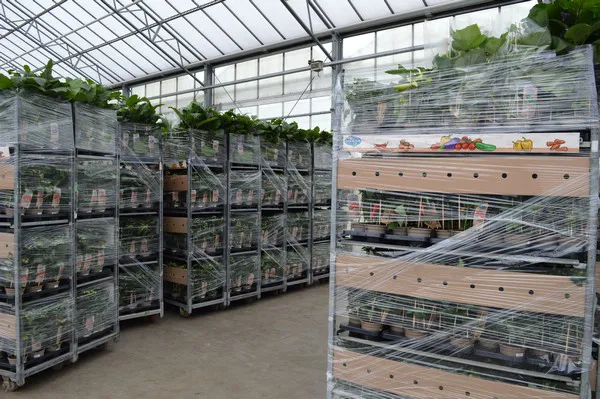Every nursery is different, but few nurseries have as much to see as at Burgemeester Crezeelaan 12 in De Lier, Netherlands, around the start of spring. At this location of Vreugdenhil Young Plants, which together with Van der Klugt accounts for more than 40 ha of cultivation of just about everything grown in horticulture, the entire Pick & Joy range is grown, collected, and shipped. Together with Petra Molenaar, who is responsible for sales together with two colleagues, we take a tour.

Petra Molenaar in a cap picking tomatoes. Hygiene is important. Without a suit and disinfecting your hands, you don't get in.
Now is a good time for that tour as well, seeing as, in a few months, millions of Pick & Joy picking vegetable plants in no less than 22 different varieties and flavors will be delivered. Petra explains that, besides growing vegetable plants for professional horticulture, the company has always been active in growing all possible garden plants. However, that is a tough market as everyone already has pansies, so to speak, so the question was how to differentiate. "Credit really goes to our former director Martin Uittenbroek in that respect. The idea for a range of picking vegetables from our own distribution, which we should keep in-house and keep improving and expanding over time, came from him."

Cucumber plants are watered. If the sun is on them, they can grow up to 10 cm a day. To make sure this happens 'orderly,' the necessary sticks and clamps come into play, and employees have to go through the crop regularly.

Aubergine plants in one of the newer greenhouses.

Did you know that the flowers of an aubergine are also purple? If you look closely, you can already see a mini-aubergine at the bottom of the plant.
And indeed, this approach seems to be successful because where one has a pretty pick-your-own tomato and the other finds a cute little pepper, there is no one else with such a large assortment. An assortment that is also highly uniform: (practically) all varieties are grown in pot size 14 cm and height 40 cm, so four layers go on a trolley as standard. Breeding and cultivation take place entirely and exclusively in-house; only customers outside Europe can grow the plants by appointment. The different varieties have their own barcode and are also always sold under the Pick & Joy label wherever you find them. On an individual basis, co-branding is done, where the customer can also put their own logo on them, so to speak.

Besides Pick & Joy, other plants are also grown. Both diversity and throughput are high, which is why literally no day is the same.

Cleaning, cleaning, and more cleaning.
The range includes different varieties of tomatoes, peppers, chilies, cucumbers, strawberries, basil, and even a mini-aubergine for free sale. Some varieties are also grown in 12 cm pots and (even more exclusively) in a pot size of 19 cm. Cultivation is approached organically, using bumblebees for pollination. Where possible, extra sustainability is, of course, attempted, for instance, by using wooden bamboo canes and (from this year) cardboard cane clips.

There are a few hives in almost all areas.

Bamboo sticks and cardboard stick clips guide the crop while a bee makes itself useful.
Perhaps the main strength of the range lies in the fact that the plants all produce new fruits exuberantly over an extended period of time. Furthermore, they have all been selected for flavor, looks, compactness, self-harvesting of the fruits, and, of course, many other characteristics that are interesting for cultivation. A very special discovery is the so-called Potatom, a combination of a compact cocktail tomato and a very productive potato plant. After planting it out, consumers can enjoy delicious tomatoes after a few weeks. In season, this can reach up to 100. In autumn (mid-October), one to three kilos of potatoes can then be harvested.

Potatom. A small clip can be seen at the bottom of the plant. This is where the tomato is grafted onto the potato.

Ditto, just grafted and recovering under the tarpaulin from this serious surgical procedure.
Because of the wide and varied range of plants, all of which are labor-intensive, there are many people working all the time. Depending on the moment, this runs to as many as 300 people. Everywhere you see groups of employees working among the plants, at the potting machine, watering or building up carts, and preparing orders. Setting out and widening is done entirely by machine. In short, there is a lot involved, but that doesn't seem to get in the way of the brand's sustainable success - quite the contrary. Pick & Joy stands strong. There is no one quite like it in terms of scale and quality.

Orders are ready for shipment. Many mix carts are made, which is further illustrated by the horizontal cardboard strip on the cart.
For more information:
Vreugdenhil Young Plants 
Petra Molenaar
[email protected]
www.vreugdenhilyoungplants.com/nl
